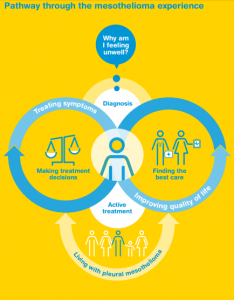What is Mesothelioma Cancer and Meshothelioma Type – Q: What is mesothelioma? A: Mesothelioma is a type of cancer that starts from mesothelial cells. These cells line the outer surface of most of the body’s internal organs, forming a membrane called the mesothelium. The membrane that covers the lungs is the pleura.
Mesothelioma Cancer and Meshothelioma Type – Q: What is mesothelioma? A: Mesothelioma is a type of cancer that starts from mesothelial cells. These cells line the outer surface of most of the body’s internal organs, forming a membrane called the mesothelium. The membrane that covers the lungs is the pleura.
Q: What are the different types?
A: There are two main types of mesothelioma, which are classified according to the area affected.
• Pleural – this forms in the covering of the lungs. Pleural mesothelioma is the most common type, accounting for about 90% of all mesotheliomas. This type of mesothelioma is called malignant pleural mesothelioma (MPM). In this book we refer to it as pleural mesothelioma or, simply, mesothelioma.
• Peritoneal – this develops in the lining of the abdomen. It accounts for about 10% of cases and is called malignant peritoneal mesothelioma. Rarely, mesothelioma occurs in the pericardium (the membrane around the heart) or the tunica vaginalis (the membrane around the testicles).
Although pleural mesothelioma develops in the chest and involves the lining of the lungs, it is not lung cancer and is diagnosed and treated differently.
Cell types of mesothelioma
Mesothelioma is also grouped according to how the cells look under a microscope. There are three main types:
• Epithelioid – cells look similar to normal mesothelial cells. This is the most common type, making up about 60% of cases.
• Sarcomatoid – cells have changed and look like cells from fibrous tissue. Accounts for about 15% of cases.
• Mixed or biphasic – has epithelioid and sarcomatoid cells. These make up about
25% of all cases. Mesotheliomas can differ in the way they grow. Some form a mass; others grow along the pleura forming a thick covering on the lungs. – What is Mesothelioma Cancer and Meshothelioma Type
People who develop mesothelioma due to asbestos exposure may be able to claim compensation. It’s important to get legal advice from an experienced lawyer as soon as possible after diagnosis.
Q: What are the symptoms? A: The earliest signs of pleural mesothelioma are often vague and similar to other conditions or diseases. If you are concerned, especially if you think you’ve been exposed to asbestos, see your general practitioner (GP).
Shortness of breath (breathlessness) – Most people with pleural mesothelioma experience breathlessness.
You may feel like you can’t catch your breath no matter what you do. It usually feels worse with activity or when you are lying down.
In early mesothelioma, breathlessness is caused by a build-up of fluid in the chest (pleural effusion). for information on how this can be treated. Pain – This can be a sharp pain in the chest, which affects your breathing, or a dull pain in the shoulder and upper arm.
The pain might not improve with pain relievers. Other general symptoms – Less commonly, people notice loss of appetite with weight loss, a persistent cough, or a change in their coughing pattern. Some people also experience heavy sweating, especially at night. – What is Mesothelioma Cancer and Meshothelioma Type
Q: What will it mean for me? A: When your doctor first suggests that you may have pleural mesothelioma, you and your family will be understandably shocked. It’s common to have many questions and concerns about what the diagnosis will mean for you.
To understand what is happening, it may help to break down the process into a series of steps. The diagram opposite is a guide to the main steps. Mesothelioma is different for everyone and you may not go through each step in the order shown.
You can use the diagram to see what stage you are at and read the chapter relevant to you. The diagnosis stage (See Booklet) is represented as a central pathway leading to active treatment (See Booklet). – What is Mesothelioma Cancer and Meshothelioma Type
This will involve making treatment decisions about the best care for you (See Booklet). During these periods, your health care team will also focus on treating symptoms and improving your quality of life(See Booklet).
The blue arrows represent the quality of life experienced while living with pleural mesothelioma (See Booklet).
Depending on the impact of pleural mesothelioma on your health, you may experience periods of relatively good health when symptoms are under control or less active.
These alternate with periods when symptoms are less controlled and the intensity of treatment needs to be increased to improve quality of life. For questions you may want to ask your doctor, (See Booklet). What is Mesothelioma Cancer and Meshothelioma Type
